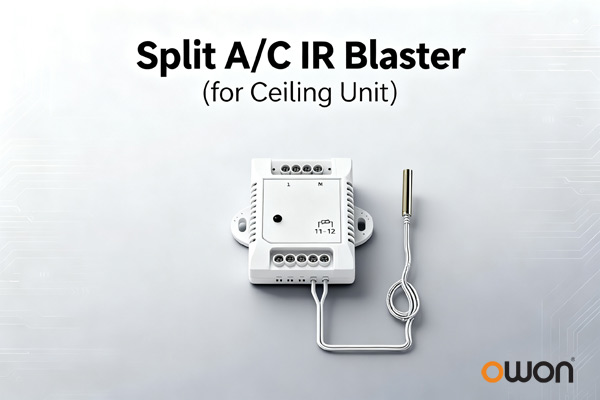To break down the term clearly—especially for B2B clients like system integrators (SIs), hotel operators, or HVAC distributors—we’ll unpack each component, its core function, and why it matters for commercial applications:
1. Key Term Breakdown
| Term | Meaning & Context |
|---|---|
| Split A/C | Short for “split-type air conditioner”—the most common commercial HVAC setup, where the system splits into two parts: an outdoor unit (compressor/condenser) and an indoor unit (air handler). Unlike window A/Cs (all-in-one), split A/Cs are quieter, more efficient, and ideal for large spaces (hotels, offices, retail stores). |
| Zigbee IR Blaster | “Infrared (IR) Blaster” is a zigbee device that emits infrared signals to mimic the remote control of other electronics. For A/Cs, it replicates the commands of a traditional A/C remote (e.g., “turn on,” “set to 24°C,” “fan speed high”)—enabling remote or automated control without physical interaction with the A/C’s original remote. |
| (for Ceiling Unit) | Specifies that this IR Blaster is designed to work with ceiling-mounted indoor split A/C units (e.g., cassette-type, ducted ceiling A/Cs). These units are common in commercial spaces (e.g., hotel lobbies, mall corridors) because they save wall/floor space and distribute air evenly—unlike wall-mounted split A/Cs. |
2. Core Function: How It Works for Commercial Use
A Split A/C Zigbee IR Blaster (for Ceiling Unit) acts as a “bridge” between smart systems and legacy ceiling A/Cs, solving a critical B2B pain point:
- Most ceiling split A/Cs rely on physical remotes (no built-in smart connectivity). This makes it impossible to integrate them into centralized systems (e.g., hotel room management, building automation).
- The IR Blaster mounts near the ceiling A/C’s IR receiver (often hidden in the unit’s grille) and connects to a smart gateway (e.g., OWON’s SEG-X5 ZigBee/WiFi gateway) via WiFi or ZigBee.
- Once connected, users/SIs can:
- Control the ceiling A/C remotely (e.g., a hotel staff adjusting lobby A/C from a central dashboard).
- Automate it with other smart devices (e.g., “turn off ceiling A/C if a window is opened” via a ZigBee window sensor).
- Track energy usage (if paired with a power meter like OWON’s PC311—see OWON’s AC 211 model, which combines IR Blasting with energy monitoring).
3. B2B Use Cases (Why It Matters for Your Clients)
For SIs, distributors, or hotel/HVAC manufacturers, this device adds tangible value to commercial projects:
- Hotel Room Automation: Pair with OWON’s SEG-X5 gateway to let guests control ceiling A/C via a room tablet, or let staff set “eco-mode” for unoccupied rooms—cutting HVAC costs by 20–30% (per OWON’s hotel case study).
- Retail & Office Spaces: Integrate with a BMS (e.g., Siemens Desigo) to adjust ceiling A/Cs based on occupancy (via OWON’s PIR 313 zigbee motion sensor)—avoiding wasted energy in empty areas.
- Retrofit Projects: Upgrade older ceiling split A/Cs to “smart” without replacing the entire unit (a $500–$1,000 savings per unit vs. buying new smart A/Cs).
4. OWON’s Relevant Product: AC 221 Split A/C Zigbee IR Blaster (for Ceiling Unit)
OWON’s AC 221 model is built for B2B needs, with features that address commercial requirements:
- Ceiling Unit Optimization: Angled IR emitters ensure signal reach to ceiling A/C receivers (even in high-ceiling lobbies).
- Dual Connectivity: Works with WiFi (for cloud control) and ZigBee 3.0 (for local automation with OWON zigbee sensors/gateways).
- Energy Monitoring: Optional power metering to track A/C usage—critical for hotels/retailers managing energy budgets.
- CE/FCC Certified: Compliant with EU/US standards, avoiding import delays for distributors.
Post time: Oct-12-2025
